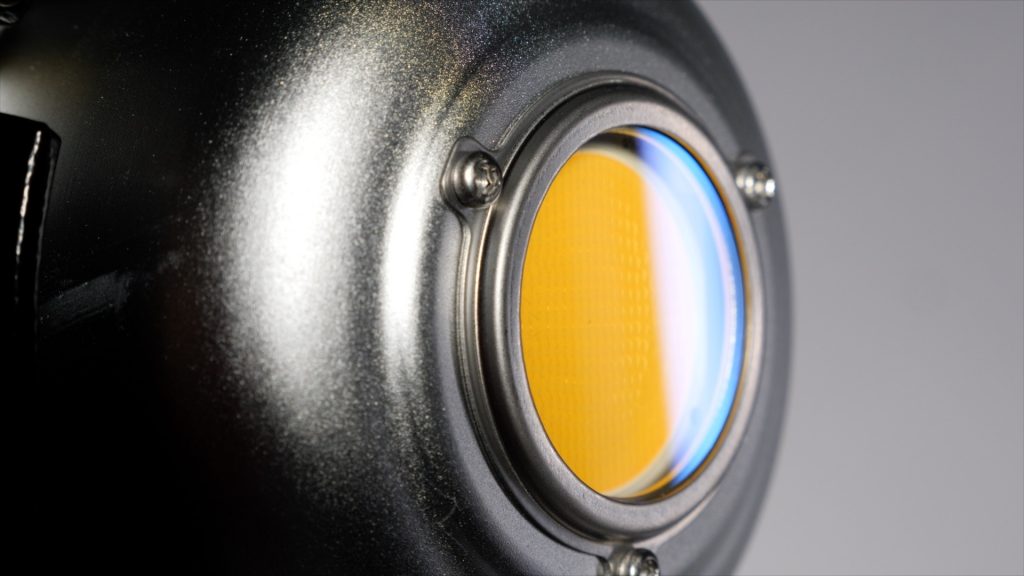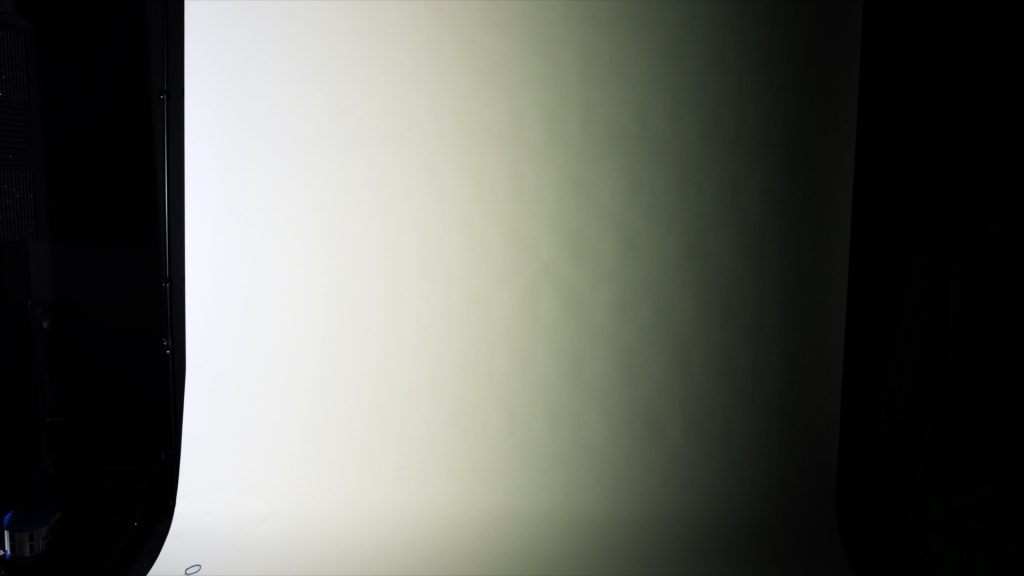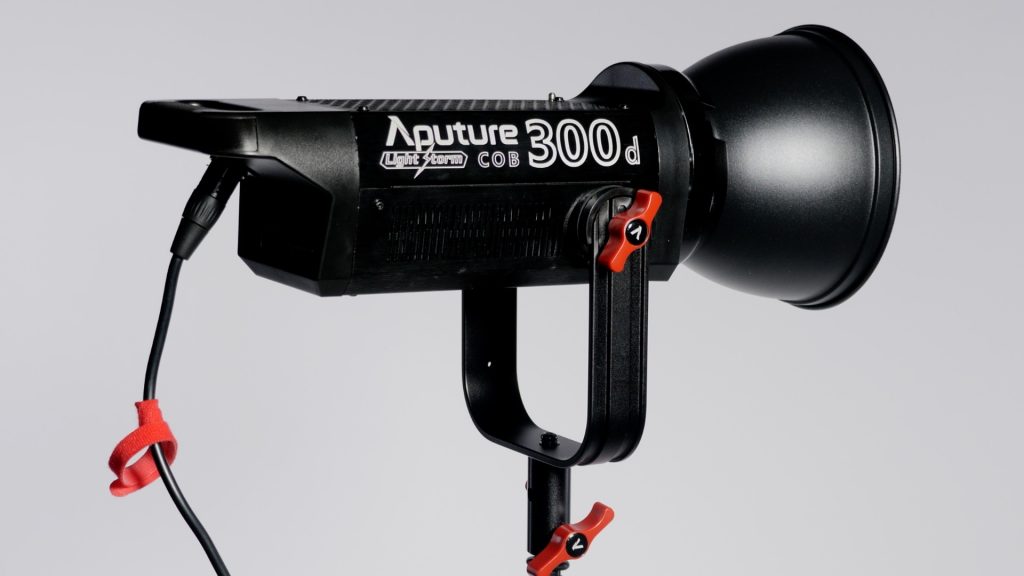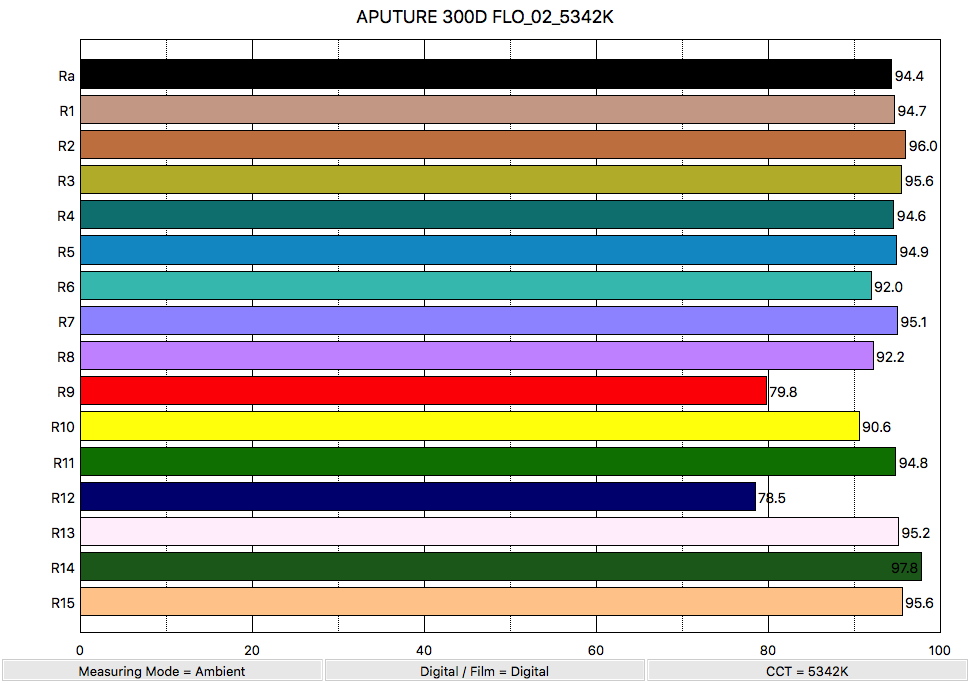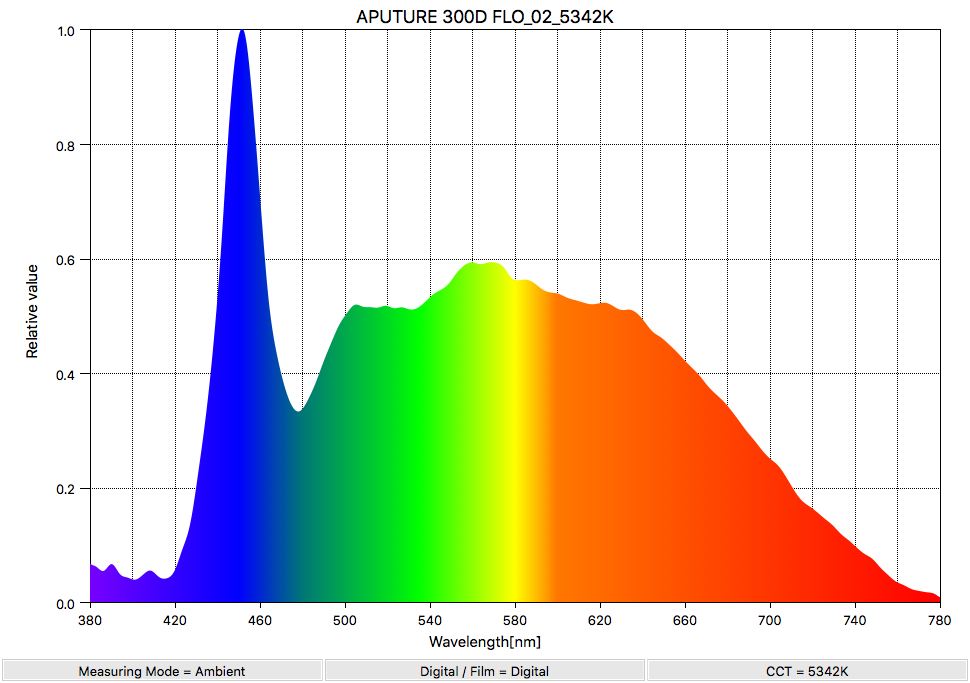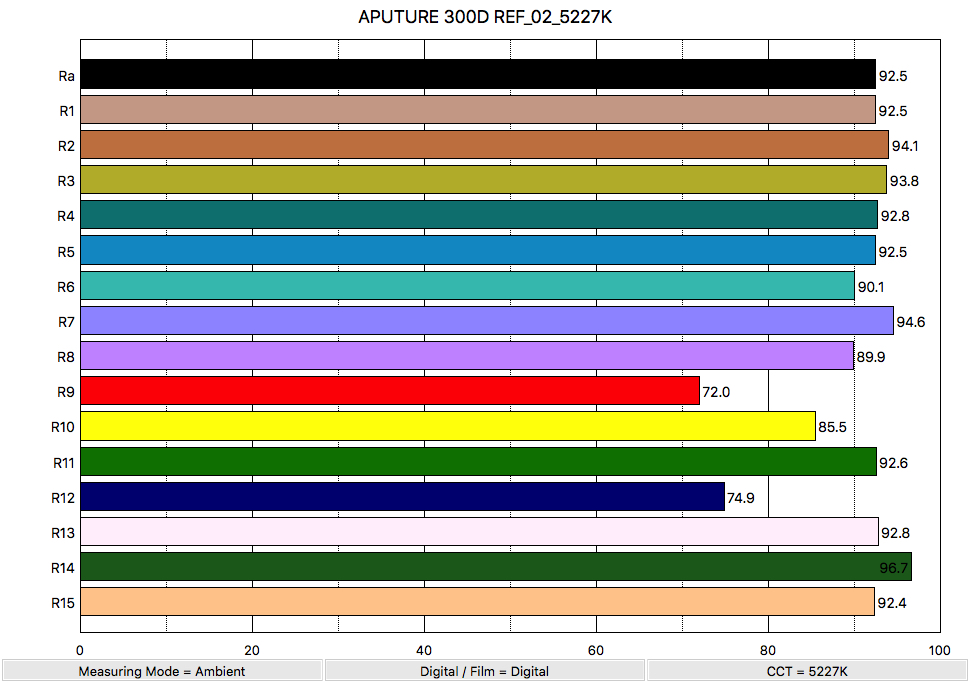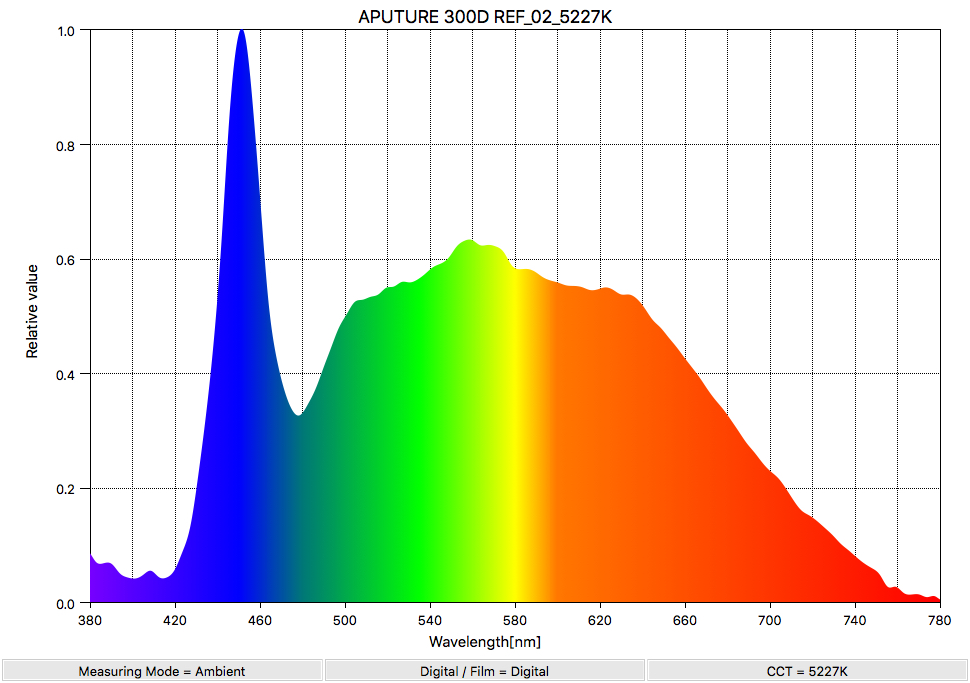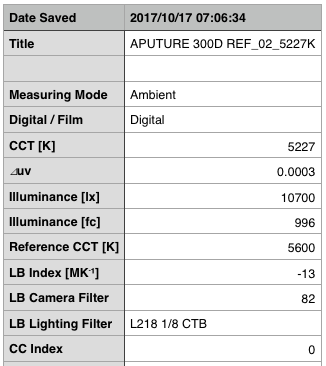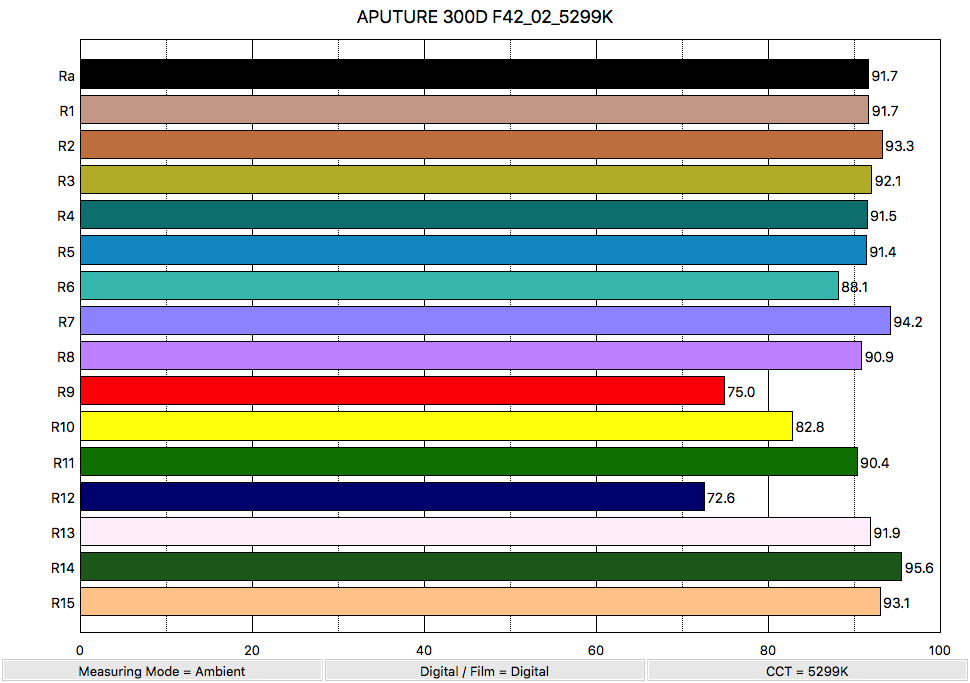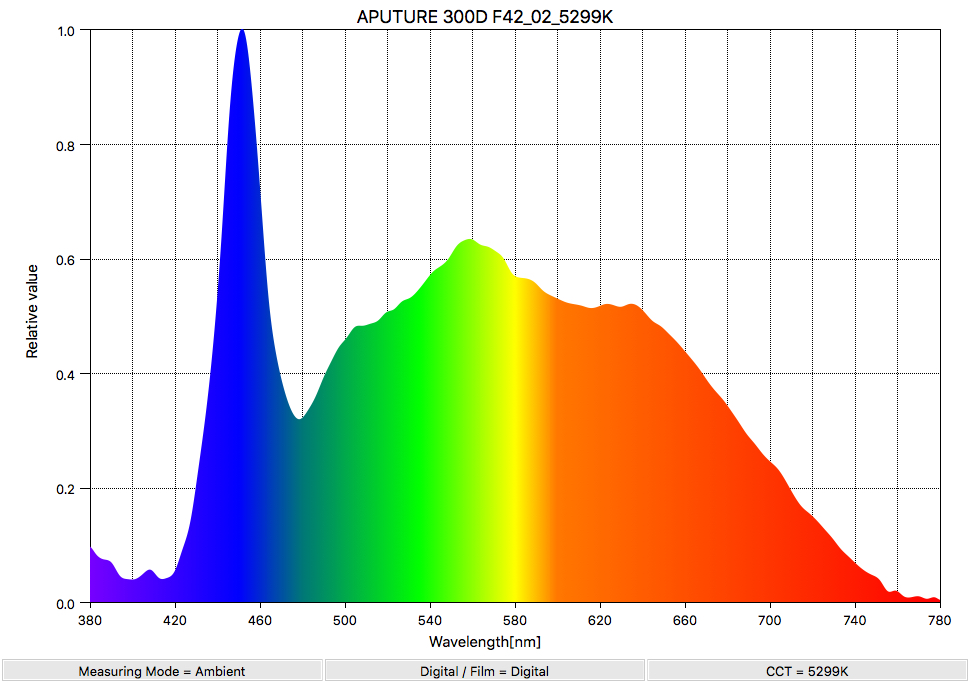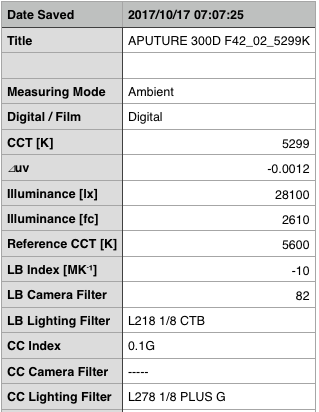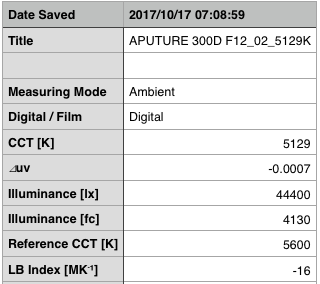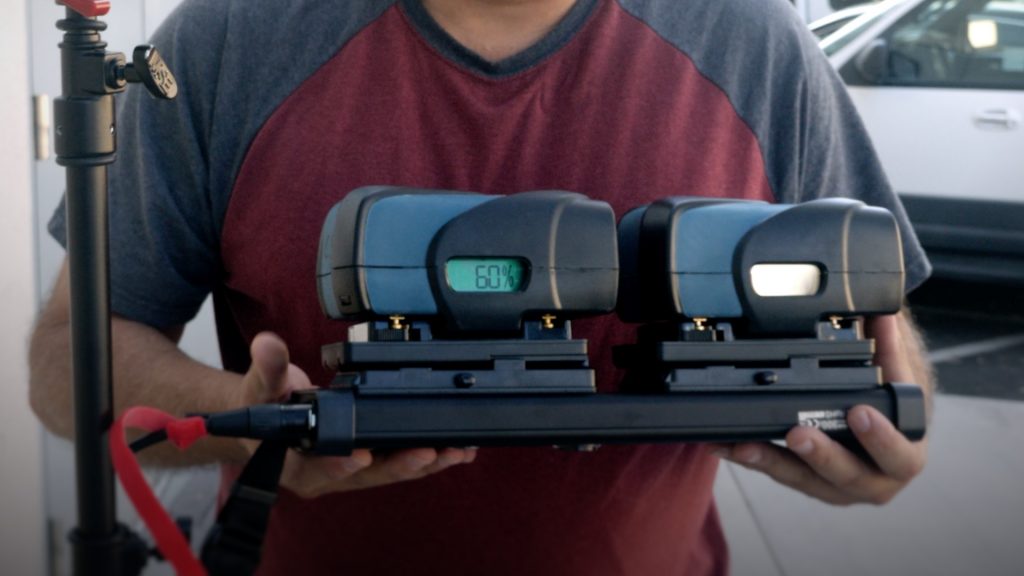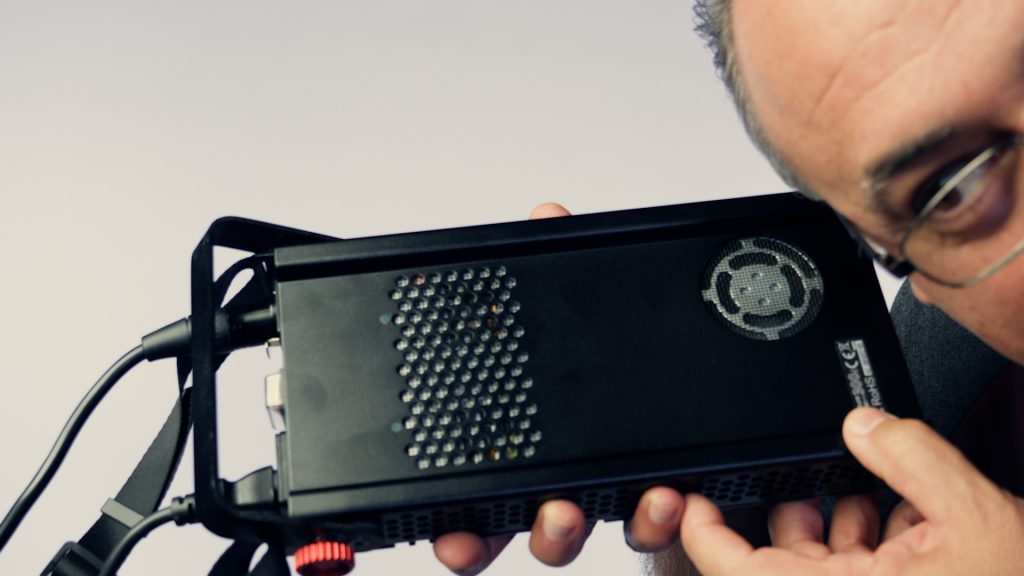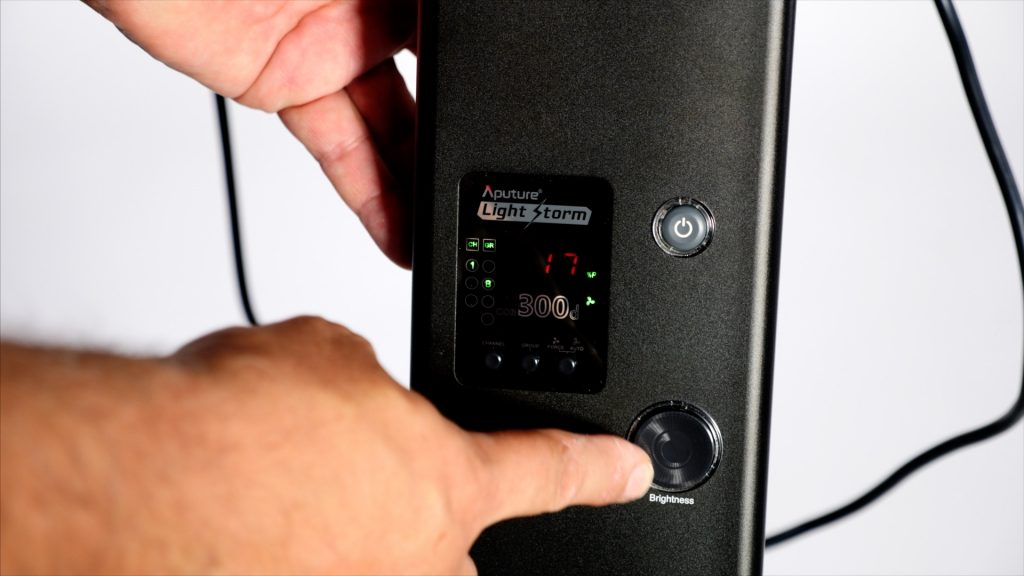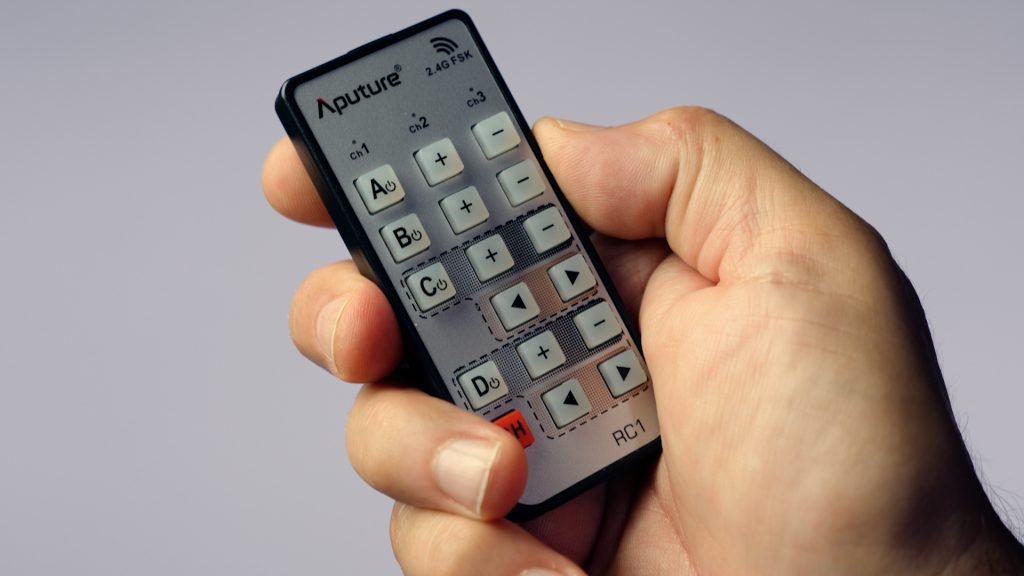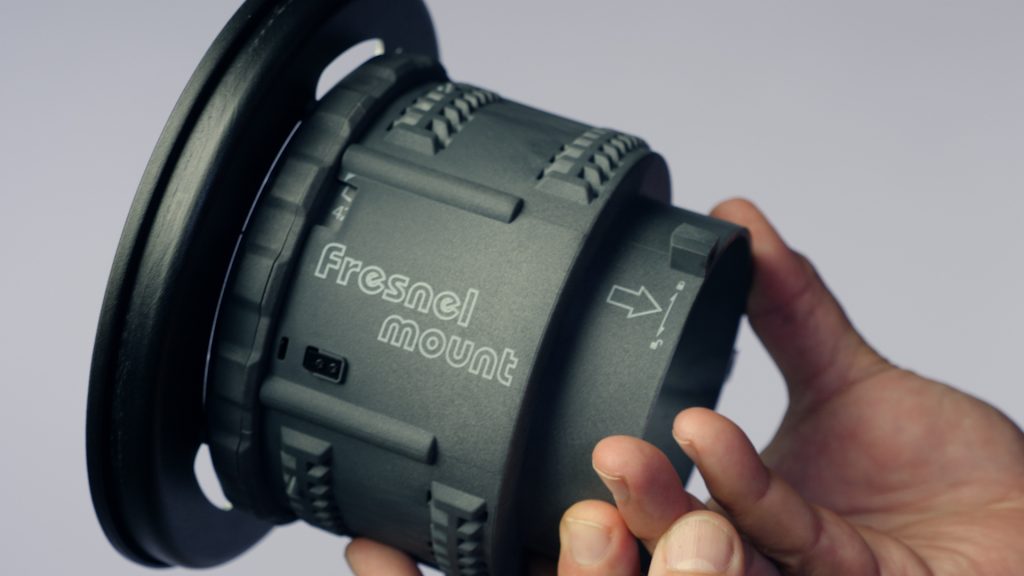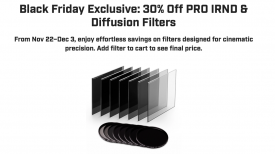The Aputure LS C300d is a powerhouse fixture. Aputure has been bringing out lighting fixtures in the last couple years that are moving the company in a different direction with better build quality and higher output. They still are considered a value, but the fixtures are getting so much better. I personally think this move separates them from the pack giving indie and lower budget filmmakers better tools for less money. It’s a great mantra and one that the Aputure LS C300d fits into perfectly. The Aputure LS C300d is Aputure’s highest output light fixture to date, as well as the most anticipated.
We here at Newsshooter gave the LS C300d our “Best Lighting Product Award” at NAB 2017. Yeah, we liked it!
Let’s start off with the big COB. The LS C300d has a glass filter in front of the COB LED for two reasons. One is to protect the COB LED array and second, it is a color correction filter that has magenta added to make the LS C300d more color accurate.
When using the LS C300d without any modifier (bare bulb) it creates a slight green tint at the edges of the light’s cast. I don’t see it being an issue since it’s only visible on the inner edge of the falloff in an area of the light that is unusable. In this shot, the front of the C300d is facing the wall on the left. It’s very much on the edge. This is a new one for me and Aputure states: “To avoid this, it’s recommended to use LS C300d with the included modifier, or with the Aputure fresnel or light dome. If using the light bare bulb is a necessity, it is recommended that you use a frosted glass in front of the LS C300d.” I’m assuming the frosted glass is a frame with diffusion.
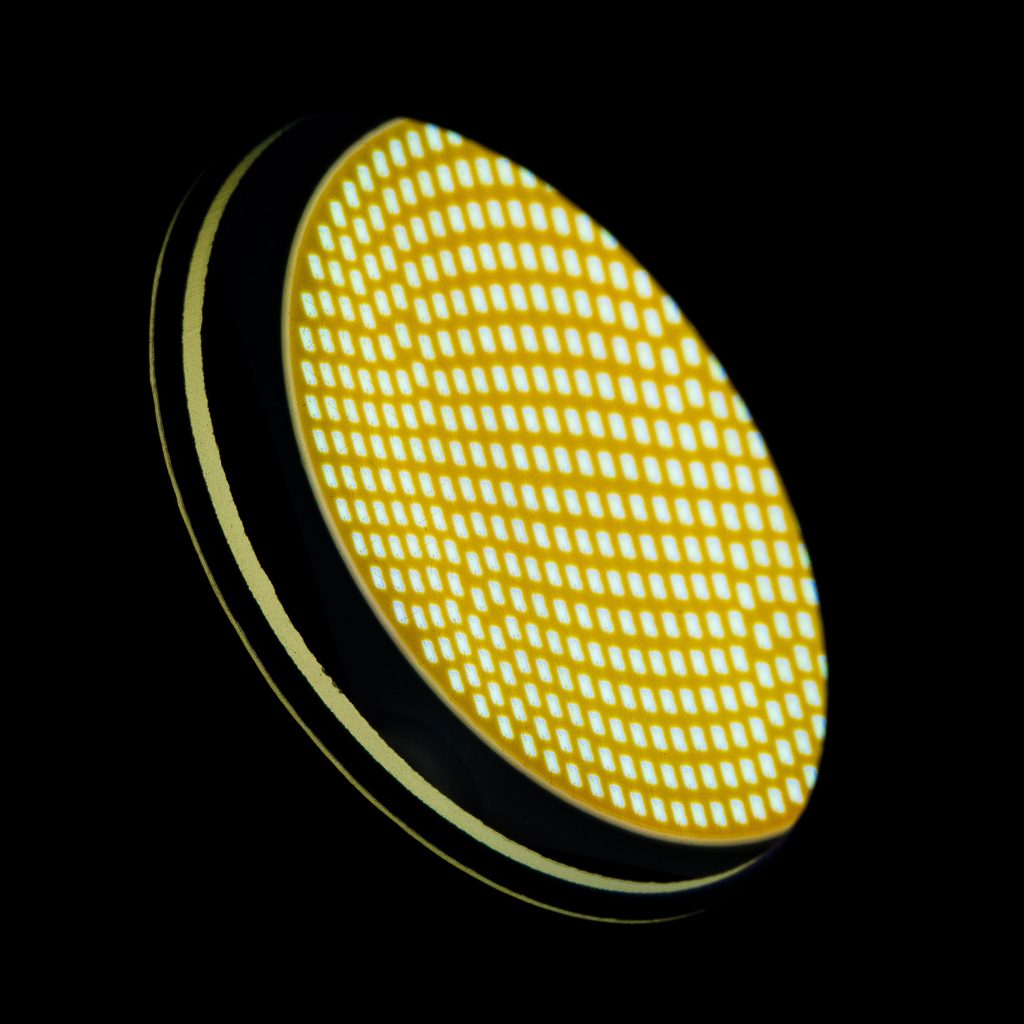 I’m fascinated by the engineering involved in the COB LED cluster. Here is a macro shot that shows the tiny LED’s in the COB array that you can’t see with the naked eye.
I’m fascinated by the engineering involved in the COB LED cluster. Here is a macro shot that shows the tiny LED’s in the COB array that you can’t see with the naked eye.
The LS C300d pulls approximately 300 watts and puts out a lot of light. Just how much? Well, let’s just dive into the numbers now.
I took several readings at one meter with and without the included modifier, I then also measured the readings with the fresnel attachment. All readings are performed with a Sekonic C-700 Spectromaster from 1 meter (3.3ft) to the front element. Let’s start with it uncorked!
Aputure LS C300d with no modifier
With no modifier attached the light recorded an average CRI (R1-R8) of 94.4 and an extended CRI (R1-R15) of 92.49. For rendering skin tones accurately it recorded 79.8 for R9 (red), 95.2 for R13 (closest to caucasian skin tones), and 95.6 for R15 (closest to Asian skin tones).
The LS C300d glass filter on the front of the COB is adding magenta to balance the color better. The readings I got from the Sekonic C-700 showed that the filter is definitely doing its job. The light recorded a 0.3G CC reading. This reading is not enough to be anywhere close to having to add a color correction gel (this is only required if the CC reading shows a +/- reading of 1.0 or greater. Despite this, at least on paper, the light only recorded scores of 79.8 for R9 (red), and 78.5 or R13 (blue), so that missing information in the spectrum should cause the light to have a very small push towards green.
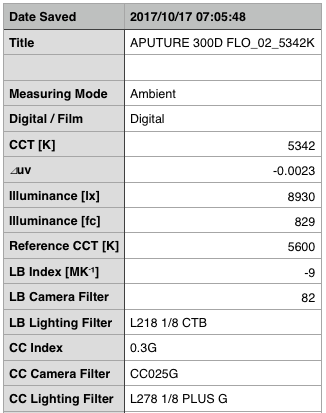 Output readings from one meter no modifier
Output readings from one meter no modifier
- 8930 LUX
- 829 footcandles.
The light recorded a Kelvin color temperature of 5342k, which is reasonably close to its advertised 5500K (+/-200K) color temperature.
Aputure LS C300d with modifier
The average CRI dropped a few points to 92.5 from 94.4 with the modifier attached. This could be the green spike mixing in, however, it’s so slight I doubt it’s noticeable. The extended CRI (R1-R15) comes in at 90.
Output readings from one meter with modifier
- 10,700 LUX
- 996 footcandles.
Aputure LS C300d with fresnel at 42 degree
With the fresnel attached it has a slight effect on color however it’s so slight that wouldn’t be noticeable. The average CRI is 91.7. The extended CRI (R1-R15) comes in at CRI 89
Output readings from one meter with fresnel at 42-degree
- 28,100 LUX
- 2610 footcandles
As you can see the fresnel is doing its job of gathering the light and punching it through the lens. With the fresnel, you get 17,400 more LUX. That is more than double the output when using it without the fresnel. At $69 it’s definitely worth having one for the C300d as well as the C120d series fixtures.
Just for fun here is what the LS 300d gets you at the 12-degree spot position.
Output readings from one meter with fresnel at 12-degree
- 44,400 LUX
- 4130 footcandles
That’s all for the meter testing part. I feel the color rendition is excellent. It’s funny how we see light in such a different way than the camera captures it. Don’t trust what you see. Trust what the camera sees.
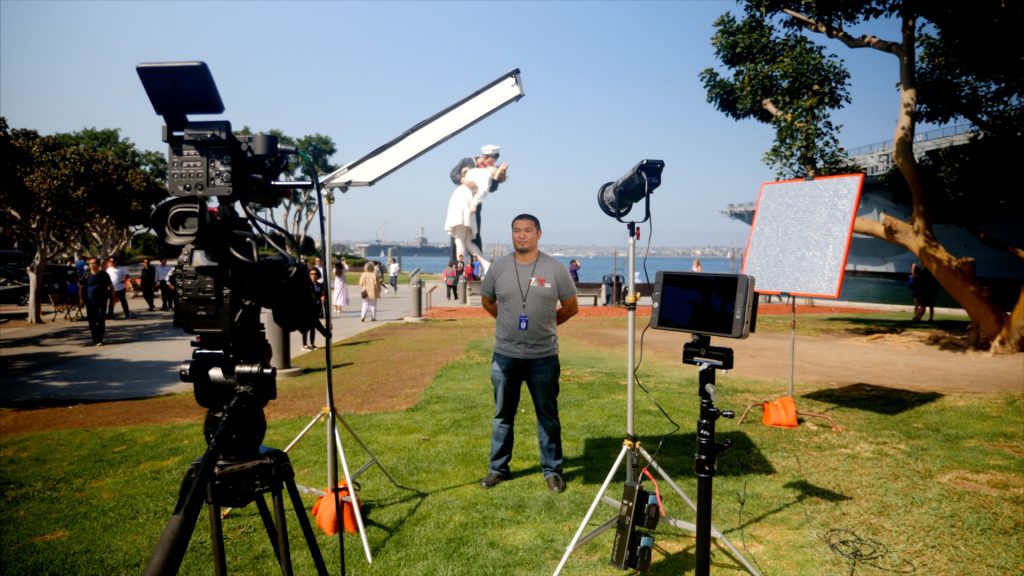 I tested the light on a shoot outdoors and I was impressed with how it performed. I put up a 4×4 to diffuse the sun that was behind me and put a bounce board up for a little backlight.
I tested the light on a shoot outdoors and I was impressed with how it performed. I put up a 4×4 to diffuse the sun that was behind me and put a bounce board up for a little backlight.
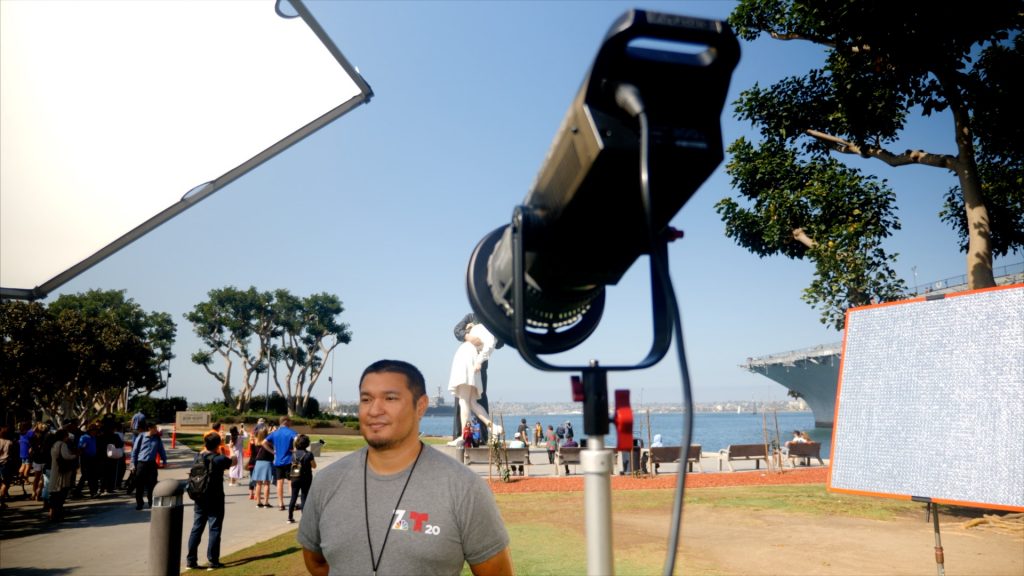 The LS C300d was my key with the fill provided by the sun going into the 4×4 frame. It worked great! The color is really good and it didn’t give me any issues with skin tone in post. The C300 was set to 5600K
The LS C300d was my key with the fill provided by the sun going into the 4×4 frame. It worked great! The color is really good and it didn’t give me any issues with skin tone in post. The C300 was set to 5600K
The LS C300d is so bright it can be used in many ways. With a light that is capable of this level of output, shooting through a 4×4 frame of diffusion or attaching a softbox or beauty dish is will be popular choices and deliver nice soft lighting.
Powering the LS C300d
The Aputure LS C300d is bright and it also needs pretty hefty batteries for remote use. To use the LS C300d remotely you are going to need some batteries. The LS C300d I received for this review came with V-Lock battery plates. since I don’t have V-lock batteries I used two Gold Mount adapters to power the LS C300d.
This part could be a deal breaker for some due to the cost of these batteries. The fixture requires a 12A battery with a capacity of at least 190WH. These are expensive and you need two, but realistically you need four. These range from $350 to $800 depending on the brand plus a charger. With two Anton Bauer Digital 150’s I got approximately 50 minutes of 100% output. I will say the controller being so long isn’t my favorite design. When you add two beefy batteries, it does get heavy and awkward to hold or position. I tended to keep it lower on the stand to double as a weight for the stand like a sandbag.
Aputure LS C300d kit
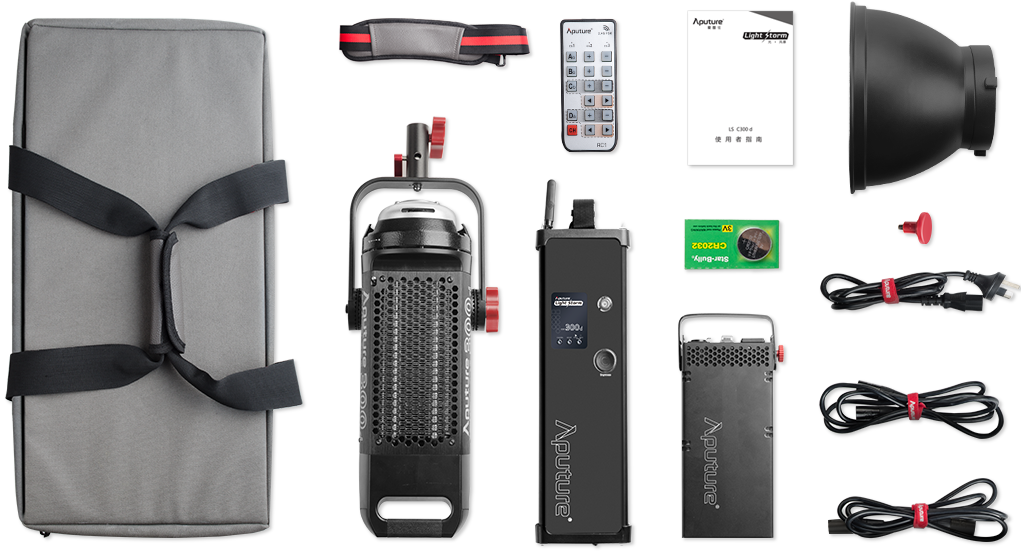
Looks familiar right? You get all this and a really nice case to transport it. I highly recommend getting a longer AC cord as the included 6′ one is pretty short. Unfortunately, there is no room for extras like the fresnel but I suppose you could take the modifier out and stick the fresnel in.
The fixture has two fans to keep it cool and it does get warm. The fans run at two different rotation speeds to avoid audio stacking making it loud. On the controller, you can have the C300d run the fan continuously or automatically run when needed. I couldn’t hear any noise coming from the main unit of the LS C300d, a very effective design. However, the ballast is another story.
The ballast has a very impressive build to it. It’s designed to be on the ground, however, It also has a small fan and it’s louder than it should be. In fact, I’m a little concerned with it. The LS C300d is a really bright light and using it in close proximity to the talent on camera is probably not it’s strength due to its punchy bright output but if you are using it as your all-rounder you might have issues. If the ballast is close to the audio source you will hear it, especially in a studio environment. Best to try and block it somehow or get it away from talent as far as you can. All sets are different but it does concern me. This has me scratching my head here. I don’t understand all the attention of the quiet fans on the LS C300d fixture only to have the ballast use a less effective fan that is audible. Hopefully, this can be addressed.
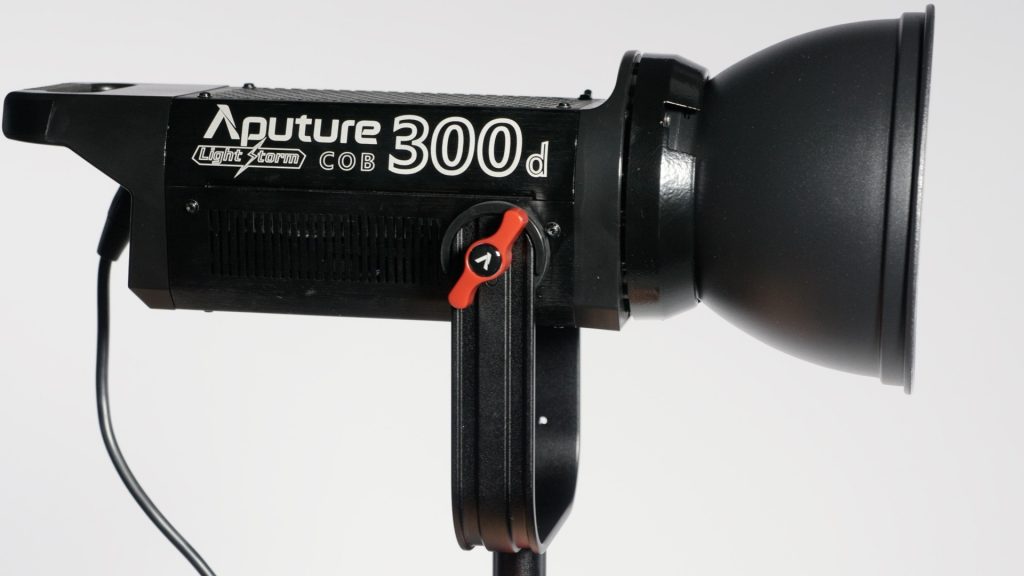 As far as build quality it’s right up there with the 120 series lights. Solid. The controller is well, HUGE! It’s so long it looks awkward but to accommodate those big batteries it has to have room for them. I think I would have preferred a different solution to this design, however, it works fine, just big.
As far as build quality it’s right up there with the 120 series lights. Solid. The controller is well, HUGE! It’s so long it looks awkward but to accommodate those big batteries it has to have room for them. I think I would have preferred a different solution to this design, however, it works fine, just big.
One thing about the way the LS C300d is designed, and this goes for the 120d as well is you end up with three pieces of kit and three cables that have to be set up to use the light. I like simplicity and prefer the one cable style. It does take a few more minutes to put the light up and hang the controller. Having the controller separate does have its advantages since you have easy access to the settings if the light is up high on a stand, but it can take a beating overtime hanging on the stand. Plus you have a wireless remote if you want to change the output or turn the light off.
I would like to see the controller functions on the fixture and the battery plates attached to the ballast. This would eliminate the need to hang it and get rid of one cable. The ability to use batteries so easily is a big plus but the current design won’t allow for batteries to be on the fixture. Just my $0.02.
The controller has an On/Off button and output wheel on the front, plus a fan control. You can set it to run constantly or in auto mode. The fan will kick in when needed. You also pick the channel for the remote on the controller.
Like so many Aputure lights, the LS C300d comes with a remote control that can be used with several other lights. It’s a very cool way to control them and a feature more light fixtures should have. In order to use the remote, the fixture has to be manually turned on first. Then you can dim and turn it off with the remote.
Add-ons
If you buy an LS C300d you will definitely need to get the Bowens fresnel. As you can see in the test results you get twice the punch when you use it, plus you can shape the light with barn doors attached. Aputure makes a lot of nice modifiers too like the light dome and light dome mini and again any Bowens mount modifiers will work. I recently tried a 28″ Beauty Dish and love the soft light you get. The options are really great for this fixture.
Competition
The Aputure LS C300d doesn’t appear to have any major competition at its price, but if you are looking for high output LED lights it’s also worth considering lights such as the Rayzr 7 7″ 300W Daylight LED Fresnel ($1,339USD), and Lupo Dayled 2000 ($1585USD). Both of these light have the added benefit of being fresnel fixtures, but are a lot bigger and heavier than the Aputure LS C300d.
The LS C300d is an innovative product with a ton of useful features built into it. I love that I can add so many different modifiers to shape and diffuse the light. Having so much punch with the fresnel attachment makes it a portable outdoor light that can easily replace a HMI and a generator. That’s a big deal. Yes, you will need some beefy batteries to do this but for on location portability, it’s still a bargain at $1099 plus batteries. Heck if you don’t want to own those beasts you could always rent them when needed. One more thing about that noisy ballast. The LS C300d isn’t a fixture for close proximity to talent since it’s such a high output light it’s better served on set in other ways. If this is going to be your main keylight you might have to deal with the ballast fan.
All in all the Aputure LS C300d is a really good deal at $1099USD. It delivers a lot of light for the price. Since the Bowens mount is so commonly used by other manufacturers, there are a lot of options to modify the light. Yes, it has some issues but you can’t get this much light for the price in another fixture. Using batteries can be an expensive option if you don’t already have them. Fortunately, I do but it’s an expensive option for those that don’t. Overall, the LS C300d delivers great color & high output all at a great price.
Let us know what you think of the LS C300d or have any other questions in the comments below.
Ted Sim from Aputure has provided a response in the Facebook Aputure User Group to the growing concern about the green tint being reported on some units. It’s a positive sign that they are addressing customers concerns and have a few fixes in the works.
The colored edge is a difficulty we ran into between pre-production and mass production with the 300d. We didn’t see this effect in our early trade show models, so like many of you, we were surprised to find this in our QC process. But since then, we’ve been hard at work looking for a solution.
At this point, we’ve already found a couple options to fix the problem. But like anything worthwhile, it’s going to take some time for us to fully research QC and put any of them into action. That said, know that when we do solve this issue, know we will take care of you, too. Aputure family should know that we’ve always been here to service and support our users. And if this is your first purchase with us, give us a little time so we can prove what we’re all about.

